Where is Mali?
About Mali
The Land
The People
Life and Death
Health, Energy and the Environment
Education and Work
Travel, Communication and the Media






Back to the Flags of Africa page

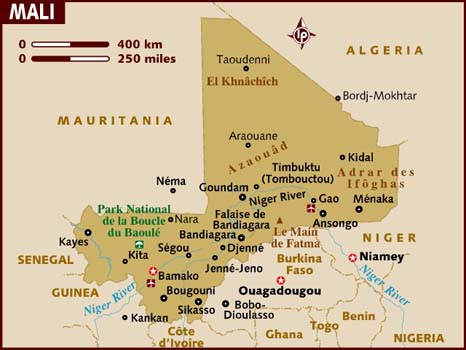


Mali is a vast country in north west Africa.
Mali is a land locked country with no sea border.
The land is mostly flat inland with rugged hills in the north east.
The geographical coordinates for the centre of Mali, also known as lines of latitude and longitude, are:-
Latitude - 17 00N
Longitude - 4 00W
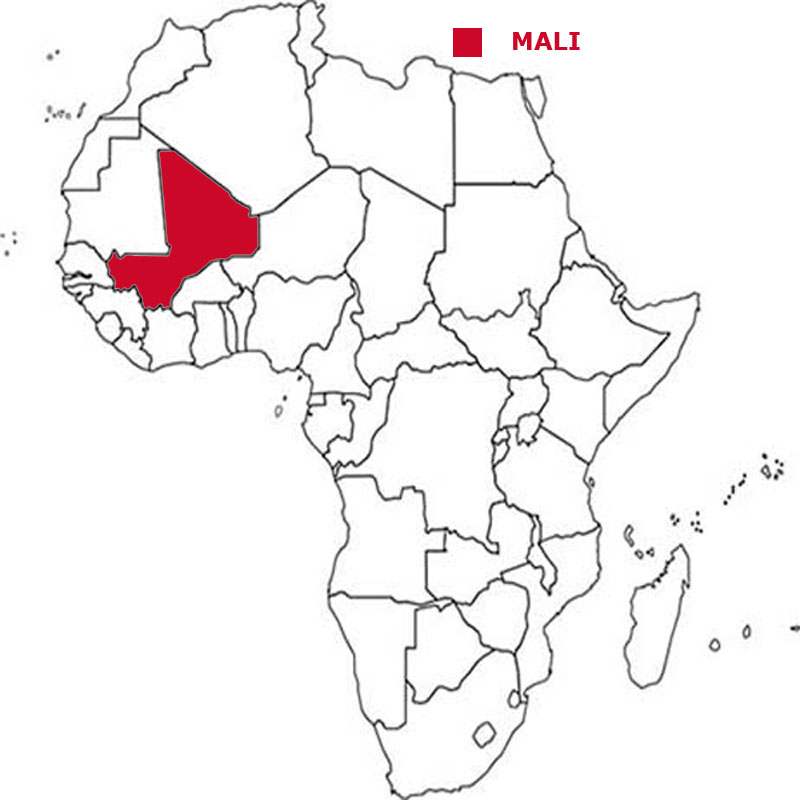

Check the weather in Bamako now.
This is the time in Bamako now
 The Malian flag is three equal vertical stripes green on the flag pole side, yellow and red.
The Malian flag is three equal vertical stripes green on the flag pole side, yellow and red.
Mali is a semi-presidential republic with a president as head of state and a prime minister as head of the government.
In elections everyone over the age of 18 can vote.
The currency in Mali is the African franc.
French is the official language.
Hear the National Anthem
These are the anthem words
We have already written our own history of England but are asking schools in Mali to provide us with a detailed history of
their own country. Check how here.
![]()
![]() Back to the top
Back to the top

The total land area of Mali is 1,220,190 sq kms which is the 8th largest in Africa.
Mali has lakes, rivers and canals which total 20,002 sq kms.
Mali has boundaries with 7 countries
- Mauritania 2,236 443 kms
- Algeria 1,359 kms
- Burkina Faso 1,325 kms
- Guinea 1,062 kms
- Niger 838 kms
- Cote d'Ivoire 599 kms
- Senegal 489 kms
Mali has a no coastline.
The highest point in Mali is Hombori Tondo at 1,155 metres.
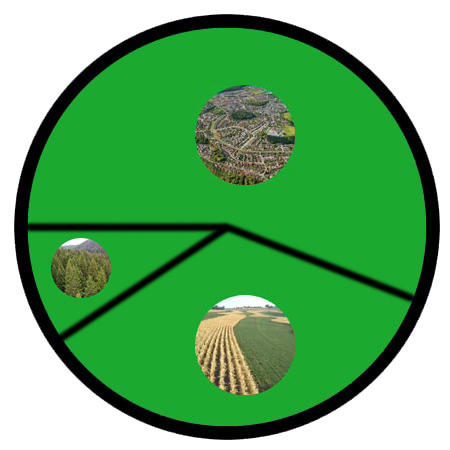

The total population of Mali is 18.43 million people, making it the 21st largest country in Africa by population.
Of this number 9.46 million are females and 8.97 million are males.
A person from Mali is called Malian.
To be a citizen of Mali, one of your parents must be a citizen of Mali. It is not sufficient to be born in Mali. You have to live in Mali for
5 years before you can begin to apply for citizenship.
The largest five cities in Mali, by population are:-
- Bamako 1,297,281 people
- Sikasso 144,786
- Mopti 108,456
- Koutiala 99,353
- Ségou 92,552
 Each little Owlbut is 1 person and
the big yellow rectangle is 1 sq km. After a while you can compare countries and see which ones are the most crowded. Remember it is only an average as
more people live closer together in towns and cities than in villages out in the country.
Each little Owlbut is 1 person and
the big yellow rectangle is 1 sq km. After a while you can compare countries and see which ones are the most crowded. Remember it is only an average as
more people live closer together in towns and cities than in villages out in the country.
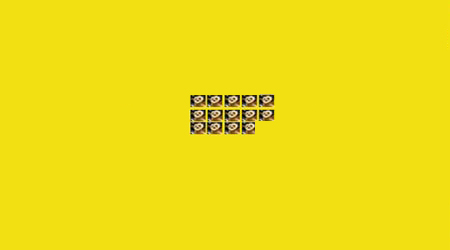
42.4% of the people live in cities or towns.

The birth rate in Mali is 43.2 births per 1,000 of population
The death rate in Mali is 9.6 deaths per 1,000 people.
Check this against the birth rate. If the death rate is higher than the birth rate then
the population will decrease unless immigrants arrive in the country.
There are 61.7 deaths of girls under 1 year per 1,000 of births and 73.3 deaths of boys.
The median age for females is 16.5 and for males is 15.2. The median age is that age which divides the population exactly in half so there are the same number
of people above the median age as below it.
The average age of a woman when she has her first child is 18.8.
The elderly dependency ratio is 5.1. This is the number of elderly people (ages 65+) per 100 people of working age (ages 15-64).
The potential support ratio is 19.5. This is the number of working-age people (ages 15-64) per one elderly person (ages 65+). As a population ages, the potential support ratio tends to fall, meaning there are fewer potential workers to support the elderly.
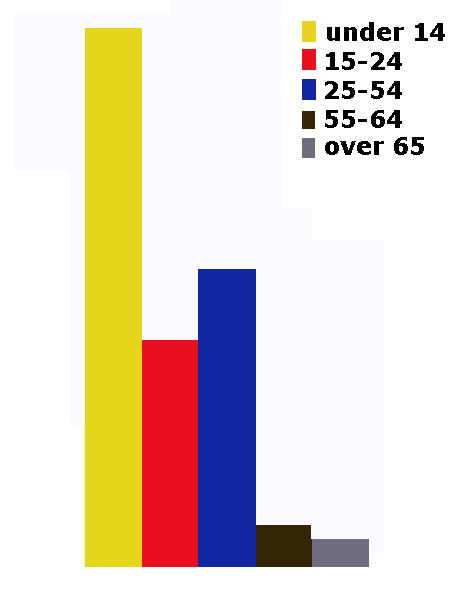
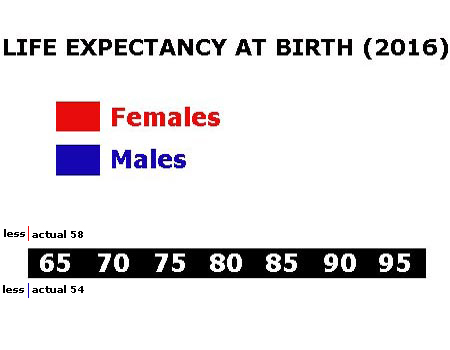

Mali spends 6.9% of its total income on health care.
There are 0.14 doctors per 1,000 people.
There are 0.1 hospital beds per 1,000 people.
8.6% of the population are estimated as obese.
96.5% of the urban population and 64.1% of the rural population have drinking water that is either piped into their home or they have access to a public tap, a protected borehole, well, spring or
protected rainwater collection facility.
37.5% of the urban population and 16.1% of the rural population have access to a flushing toilet that is connected to a sewer, a pit latrine (that is a
permanent hole in the ground that is looked after) or a composting toilet.
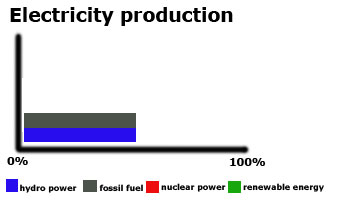
Mali releases 0.8 million metric tons of carbon dioxide by burning fossil fuels in the process of producing and consuming energy. This puts it as the 42nd highest in Africa.

Mali spends 3.1% of its total income on education.
Children usually start school at age 7 in Mali. Primary education is for six years until age 13 and secondary education must continue till 16 but can go on to 18/19. This may be followed
by further education at a university or college.
We are waiting for information for school terms in Mali.
22.2% of females and 45.1% of males are able to read and write by the age of 15.
2.2% of all people aged between 16 and 24 are not in work. Among females 2.3% are unemployed while with males 2.5% can't find work.
The total number of people available for work in Mali is 6.45 million.
 They work in the following sectors.
They work in the following sectors.
- Agriculture includes farming, fishing and forestry work
- Industry includes mining, manufacturing, construction and energy workers
- Services is everything else

There are 8 paved airports in Mali, which is the 27th highest number in Africa.
![]()
There are 593 kilometres of railways in Mali, the 31st longest in Africa.
![]()
There are 22,474 kilometres of roads in Mali, which means Mali is in 21st place for the most kilometres of roads in Africa.
![]()
There are 5 major national newspapers in Mali.
There are 20.22 million mobile phone users.
1% of the people have a fixed landline.

1.94 million people have access to the internet at home via any device (computer or mobile).


